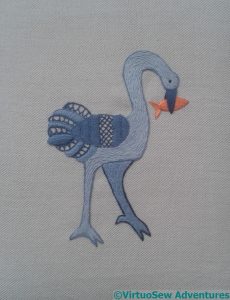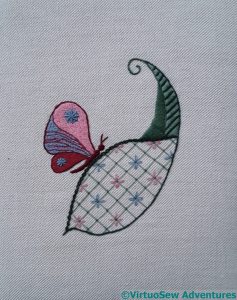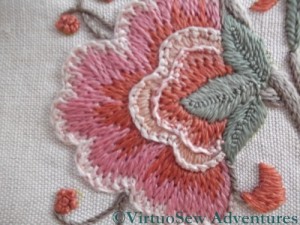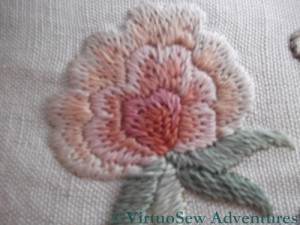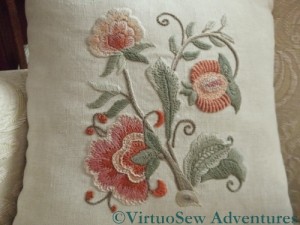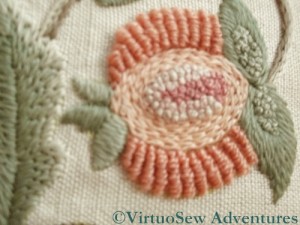Tag: crewelwork
Crewelwork Designs
I can’t remember where I found the basic outline of this heron. There’s something a bit late-medieval about him, and I found the various shapes a good way of playing with interesting stitches. He’s worked in crewel wool, apart from the orange-gold fish in his beak – that’s silk!
The main, flat colour sections of his body are worked in split stitch filling. This isn’t a technique I’m especially fond of, but it does fit in well with the style of the drawing, and it provides a plain filling that allows the trellis couching over his wing, and the half-chevron stitch in his tail to be the stars of the show.
The butterfly settling on the huge leaf in this second panel also makes use of split stitch filling, with the roundels on the wings working in spider’s web stitch, and the antennae in a single fly stitch. However, the whole reason for creating this design was to have a large space to fill with the ornamented version of trellis couching. I believe that classically, this stitch is worked much smaller and more densely, but what I was trying to do here was to marry the old style with more modern sensibilities, and opening it out creates a crisper, lighter effect.
I’ve not been able to work out what to do with these, either. They’re mounted over board, and waiting for inspiration!
Jane Rainbow Kit – second installment
The raised edges of the petals of this flower are produced by working one row of blanket stitch along the edge and then working detached buttonhole stitch into that. It creates a fairly subtle effect in real life, and it’s always satisfying to see small details like this appearing in kits.
You can also see in this close up that although I was beginning to get to grips with satin stitch, my Long and Short Stitch wasn’t very good.
Really not very good, in fact! The stitching on the second flower looks more like brick stitch. I think this is the only bit of the design I didn’t enjoy doing, and that’s entirely because I simply could not get to grips with Long and Short Stitch. No-one had told me to think “Long and Longer”, which is what has cracked it for me since then. Besides, working a colour change into such narrow rows is not the easiest way to tackle Long and Short stitch!
I did like the rows of stem stitch shading from dark to light that were used for the stems – in fact I used the same technique in the stems on the Piano Shawl. The detail of the end of the stem – concentric rows of stem stitch – was particularly charming.
The leaves in the bottom corner worked well, too. The openwork at the centre of the upper leaf makes a nice contrast with the rest of the design which is very densely stitched.
I did enjoy working this – even if it was finished at the speed of lightening!
Another Long-Ago Project – Jane Rainbow Kit
This crewelwork cushion came from a Jane Rainbow kit, which my parents gave me for Christmas about fifteen years ago. It’s the last kit that anyone’s ever bought for me, because I finished it in short order – it was done by Twelfth Night – and the family felt that it hadn’t kept me out of mischief for long enough! I’ve looked on a couple of needlework shop websites, and it seems that this design is no longer available, which I think is a pity. It was fun to do, and I learnt a couple of variations I’d not come across before.
The pomegranate shows a great variation in height and texture of stitches. I like the way the French knots used in the centre are also used for textured patches on the leaves, although I think I would be inclined, were I to work this today, to use a darker colour in the centre of the pomegranate. The ribbed pattern around isn’t made up of exceptionally long bullion knots, as you might expect, but instead is a sort of opened-out ribbed spiders web stitch. The instructions here said to pack in the stitches as much as possible to get a nicely raised effect. It worked really well – it almost looks padded!

